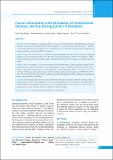Please use this identifier to cite or link to this item:
https://hdl.handle.net/20.500.14356/1002Full metadata record
| DC Field | Value | Language |
|---|---|---|
| dc.contributor.author | Dhakal, Radha Devi | - |
| dc.contributor.author | Nepal, Shobhana | - |
| dc.contributor.author | Thapa, Namuna | - |
| dc.contributor.author | Sapkota, Sushma | - |
| dc.contributor.author | KC, Sita | - |
| dc.contributor.author | Adhikari, Prativa | - |
| dc.date.accessioned | 2023-04-19T09:33:19Z | - |
| dc.date.available | 2023-04-19T09:33:19Z | - |
| dc.date.issued | 2022 | - |
| dc.identifier.citation | DhakalR. D., NepalS., ThapaN., SapkotaS., KCS., & AdhikariP. (2022). Factors Associated With Utilization of Institutional Delivery Service during Covid-19 Pandemic . Journal of Nepal Health Research Council, 20(01), 33-40. https://doi.org/10.33314/jnhrc.v20i01.3733 | en_US |
| dc.identifier.issn | Print ISSN: 1727-5482; Online ISSN: 1999-6217 | - |
| dc.identifier.uri | http://103.69.126.140:8080/handle/20.500.14356/1002 | - |
| dc.description | Original Article | en_US |
| dc.description.abstract | Abstract Background: The utilization of institutional delivery services is pivotal to improve maternal health and reducing maternal mortality amid childbirth. But COVID-19 pandemic is posturing considerable challenges to maintain essential maternal and newborn health services. So study aims to assess the factors associated with the utilization of institutional delivery during the COVID -19 pandemic. Methods: Data was collected from the 116 mothers of Kalika Municipality, Chitwan. The total enumerative sampling technique was used to include mothers who delivered a baby during lockdown (March 21 to August 21, 2020). Collected data were analysed by using descriptive and inferential statistics like chi-square test, logistic regression analysis. Results: Out of 116 mothers, 76.6% had their delivery in the health facilities. Logistic regression analysis showed several factors associated with utilization of institutional delivery such as ethnicity, respondents education status, distance to the nearest health facility, fear of traveling, fear to visit health facility (AOR= 4.923; 95% CI =1.475-16.432, p=0.001),perception on the risk of covid-19 to mother, and intrauterine transmission of COVID-19 (AOR= 19 5.472;95% CI 1.35-22.175;p= 0.017) was found to be statistically significant with the utilization of institutional delivery during COVID-19 pandemic. Conclusions: Several factors have been associated with the utilization of institutional delivery during pandemic. Women preferred not to seek healthcare due to the fear of being infected, lack of awareness, and misperception about COVID-19 and pregnancy. Therefore, the concerned authority should need to deliver a separate message to the pregnant women for a regular check-up and deliver a baby at a hospital. Keywords: COVID-19 pandemic; institutional delivery; and utilization | en_US |
| dc.language.iso | en | en_US |
| dc.publisher | Nepal Health Research Council | en_US |
| dc.relation.ispartofseries | Jan-March, 2022;3733 | - |
| dc.subject | COVID-19 pandemic | en_US |
| dc.subject | institutional delivery | en_US |
| dc.subject | and utilization | en_US |
| dc.title | Factors Associated With Utilization of Institutional Delivery Service during Covid-19 Pandemic | en_US |
| dc.type | Journal Article | en_US |
| local.journal.category | Original Article | - |
| Appears in Collections: | Vol. 20 No. 01 (2022): Issue 54 Jan-March, 2022 | |
Files in This Item:
| File | Description | Size | Format | |
|---|---|---|---|---|
| 3733-Manuscript-27864-1-10-20220606.pdf | Fulltext Download | 226.82 kB | Adobe PDF |  View/Open |
Items in DSpace are protected by copyright, with all rights reserved, unless otherwise indicated.
